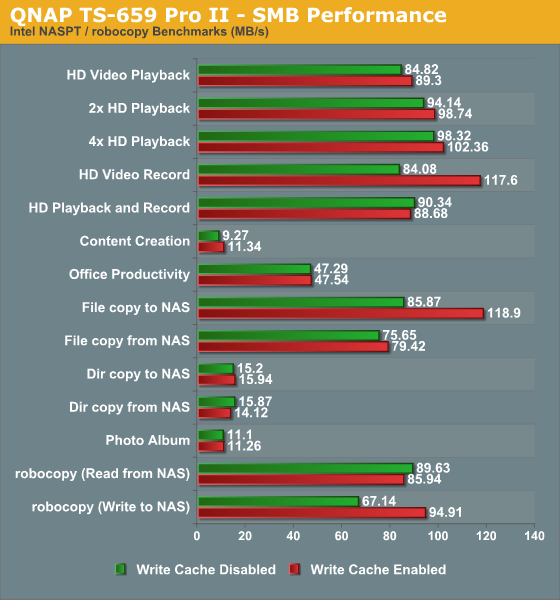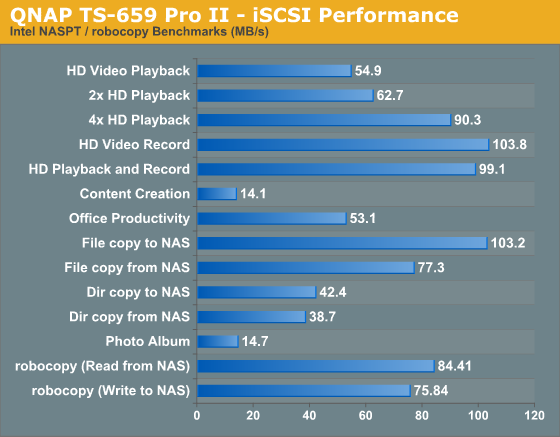QNAP TS-659 Pro II Review
by Ganesh T S on September 19, 2011 8:00 AM EST- Posted in
- IT Computing
- NAS
- QNAP
Samba shares can be set up easily by enabling the Microsoft Networking service. Under Access Rights Management, any of the folders in the NAS can be included in the 'Share Folders' section. Running the Intel NASPT benchmark and the robocopy tests gave us the following results:

Note that we have also run the benchmarks with the write cache enabled. This shows more than 35% improvement in the write intensive workloads, but the usual expected performance improvement is between 10 to 20% in general use. Unfortunately, it is recommended that the write cache be turned off for virtualized environments.
Moving on to iSCSI, it is again quite straightforward to enable the iSCSI service in the Disk Management's iSCSI subsection. The Target Management tab has a Quick Configuration Wizard to help create an iSCSI target and LUN.

In addition to the NASPT benchmarks for iSCSI, we also put the target through the HD Tune Pro benchmarks. The gallery below presents the various metrics of interest.
In order to test out NFS performance, we set up port trunking with 802.3ad for the ESA I340 in Ubuntu 11.04. rsync was used to replicate the robocopy command of transferring a 10.7 GB Blu-ray folder structure to the NAS and back from it.
| TS-659 Pro II NFS Performance in Ubuntu 11.04 | |
| Write to NAS | 67.83 MBps |
| Read from NAS | 61.30 MBps |
| . | |
















69 Comments
View All Comments
bobbozzo - Tuesday, September 20, 2011 - link
So can you add more drives to the RAID using eSATA? How many?Thanks!
ganeshts - Tuesday, September 20, 2011 - link
It supports port multipliers in the sense that you can configure share folders on it. However, I don't think RAID expansion is supported: http://forum.qnap.com/viewtopic.php?p=158110 : Note that I am unable to test this out right now because the review unit is being put under stress for one of the bugs reported elsewhere in this comments section.beginner99 - Tuesday, September 20, 2011 - link
IMHO only makes sense for business use. Only advantage to a DIY build is the small case with hot-swap. Have not seen such a case anywhere for a DIY build.But besides the case size you can get better hardware for half the price with DIY.
I'm quite astonished by the 72 watt. Do hdd's need that much power?
jmelgaard - Tuesday, September 20, 2011 - link
I Disagree that the only advantage is the small case, a DIY solution might not even be possible for some consumers as they simply won't know "how to" build your own, these boxes has a high level of convenience to them and putting together components to hit the same low power consumption could be a picky task.But ofc. it's your opinion so I can't but say mine is different.
The drives is rated at 7.4 Watts typical under read/write according to specs the Processor is according to Intel rated around 13 Watts.. that sums to 57,4 Watts... Add the rest of the components and I think it sounds fairly realistic...
DanNeely - Tuesday, September 20, 2011 - link
Most of the remainder is probably PSU inefficiency. Assuming 80% efficiency you get 71W of power in for the components you listed.asakharov - Tuesday, September 20, 2011 - link
Not long ago I had a chance to test I/O performance of QNAP TS-459 Pro II (the same generation as at article) and older TS-439 Pro II. Looks like not my, not TS-659 Pro II could really use Ethernet load balancing - no I/O performance change according to NASPT. All available Ethernet teaming type was tested. All disks are in RAID0The best I/O performance I received with one Ethernet connected to NAS.
The simplest is the fastest?
meesterlars - Tuesday, September 20, 2011 - link
I would urge you, Anand, to consider making readers of your site aware of an undisclosed but critical bug affecting QNAPs with newer firmware versions; it seems a certain combination of free space and number of files stored on the NAS can cause anything from appalling performance to data corruption and eventually data loss.The following link documents the failure of a 10TB storage node.
http://forum.qnap.com/viewtopic.php?f=189&t=46...
According to their forums, QNAP are investigating...
It seems we too might be showing symptoms of this bug at one of our customer's installations where we had two freezes last week alone, requiring customer interaction (i.e., "pull power, please"). Not ideal.
rancid-lemon - Tuesday, September 20, 2011 - link
Ouch, I've just read through this thread and seems to be a show stopper.I was looking at buying a QNAP device but this may have to go on hold.
There does seem to be some qnap support on the subject but that haven't revealed any details of a fix, time frame to solution or anything. Plus they seem to be no closer to a solution (or indeed know generally what is going on with their own system!)
Thanks for the heads up!
ganeshts - Tuesday, September 20, 2011 - link
Thanks for posting this. I am trying to recreate the issue in the unit we have, and if I am successful in doing it, I will post an addendum to the review.rancid-lemon - Tuesday, September 20, 2011 - link
Just so you are aware, having read the entire thread it seems to affect larger hard drives, 2TB+. I notice that your review system was using 1TB drives.The issue may still occur with 1TB drives though since according to that thread there seems to be an amount of uncertainty involved as to the cause.